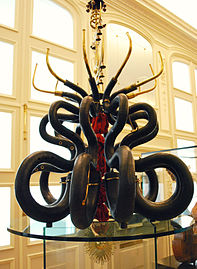Musical Instrument Museum, Brussels
 Exterior of the Musical Instruments Museum (MIM)'s Old England building | |
 Interactive fullscreen map | |
| Established | 1877 |
|---|---|
| Location | Rue Montagne de la Cour / Hofberg 2, 1000 City of Brussels, Brussels-Capital Region, Belgium |
| Coordinates | 50°50′34″N 4°21′32″E / 50.84278°N 4.35889°E |
| Type | Music museum |
| Public transit access |
|
| Nearest car park | No |
| Website | Official website |
The Musical Instruments Museum (MIM) (French: Musée des instruments de musique; Dutch: Muziekinstrumentenmuseum) is a music museum in central Brussels, Belgium. It is part of the Royal Museums of Art and History (RMAH) and is internationally renowned for its collection of over 8,000 instruments.
Since 2000, the museum has been located in the former
.History
Early history
The MIM collection was created in 1877 and was originally attached to the

The monumental five-volume catalogue of the collection Mahillon commissioned, between 1880 and 1922, also included four versions of his essay on the methodical classification of both
20th and 21st centuries
After the
With the arrival of the esteemed Latinist Roger Bragard, curator between 1957 and 1968, larger budgets became available from the Ministry of Culture, as exhibits were renovated, new personnel were hired, concerts were again organised, and new rare pieces were collected. Between 1968 and 1989, René de Mayer continued the momentum initiated by Bragard, assisted by a team of specialised scientists. It was at the beginning of the 1990s that the revival of the MIM really began, when Nicolas Meeùs took over its management (from 1989 to 1995) on an interim basis.[5] He started to design the layout of the museum in the former Old England department store, bought since 1978 by the Belgian State.[2] The restoration of the building lasted until 1994, when it won the Quartier des Arts prize for the quality of the renovation of the facades. The MIM moved under the direction of Malou Haine (from 1994 to 2009).[5] In 1998, the MIM became the official occupant of the building and it was after two years of development that the museum, renovated and resolutely modern, opened its doors to the general public.[6] Haine remains honorary curator of the museum.[citation needed]
Exhibits
The museum's collection presents Belgian musical history (including Brussels' importance in the making of recorders and various obscure proto-synthesizers (Ondes Martenot,[7] Theremin,[8] etc.) in the 18th and 19th centuries and as the home of the instrument inventor Adolphe Sax in the 19th century),[9] European musical traditions, and non-European instruments. Visitors are given infrared headphones in order to listen to almost 300 musical extracts of the instruments on display.[10] Information is provided in French, Dutch and English.
With over 7,000 pieces from all around the world, this museum houses one of the largest collections of musical instruments on the planet. Mechanical instruments are shown in the basement, traditional instruments on the ground floor, the development of the modern orchestral instruments on the first floor, and keyboard and stringed instruments on the second floor.
Besides exhibiting the permanent collection, the museum occasionally also programs temporary exhibitions and concerts of influential contemporary inventors such as the Baschet Brothers, Pierre Bastien, Yuri Landman, Logos Foundation and others.[14]
-
Exhibition space
-
Antique instruments (serpents) on display
-
Violin by Girolamo Amati (1611, Cremona)
-
Trombone with seven bells by Adolphe Sax (1876, Paris)
-
Unison accordion by Enrico Sabatini (1950)
See also
- List of museums in Brussels
- List of music museums
- Art Nouveau in Brussels
- History of Brussels
- Culture of Belgium
- Belgium in the long nineteenth century
References
Citations
- ^ "Gulliver". The Economist. Archived from the original on 25 January 2002. Retrieved 12 September 2017.
- ^ a b "Old England – Inventaire du patrimoine architectural". monument.heritage.brussels (in French). Retrieved 24 November 2022.
- ^ Damscrhroder 1990, p. 85.
- ^ State 2015, p. 166.
- ^ a b c d e f "History of the MIM | MIM". www.mim.be. Retrieved 24 November 2022.
- ^ "Building | MIM". www.mim.be. Retrieved 24 November 2022.
- ^ "Ondes Martenot | MIM". www.mim.be. Retrieved 24 November 2022.
- ^ "Theremin | MIM". www.mim.be. Retrieved 24 November 2022.
- ^ a b "Alto saxophone | MIM". www.mim.be. Retrieved 24 November 2022.
- ^ "Visit with multimediaguide | MIM". www.mim.be. Retrieved 24 November 2022.
- ^ "Galleries | MIM". www.mim.be. Retrieved 24 November 2022.
- ^ "Adolphe Sax's collection | MIM". www.mim.be. Retrieved 24 November 2022.
- John Tyrrell. London: Macmillan Publishers.
- ^ "Calendar | MIM". www.mim.be. Retrieved 24 November 2022.
Bibliography
- Damscrhroder, David (1990). Music Theory from Zarlino to Schenker. Stuyvesant, NY: Pendragon Press. ISBN 0-918728-99-1.
- State, Paul F. (2015). Historical dictionary of Brussels (2nd ed.). Lanham, MD: Rowman & Littlefield. ISBN 978-0-8108-7921-8.
External links
 Media related to Musical Instrument Museum, Brussels at Wikimedia Commons
Media related to Musical Instrument Museum, Brussels at Wikimedia Commons- Official museum website
- Entry on Musical Instrument Museum from the BBC h2g2
- Musical Instrument Museum information from Tripadvisor
- Photos of the Musical Instrument Museum from Have Camera Will Travel





